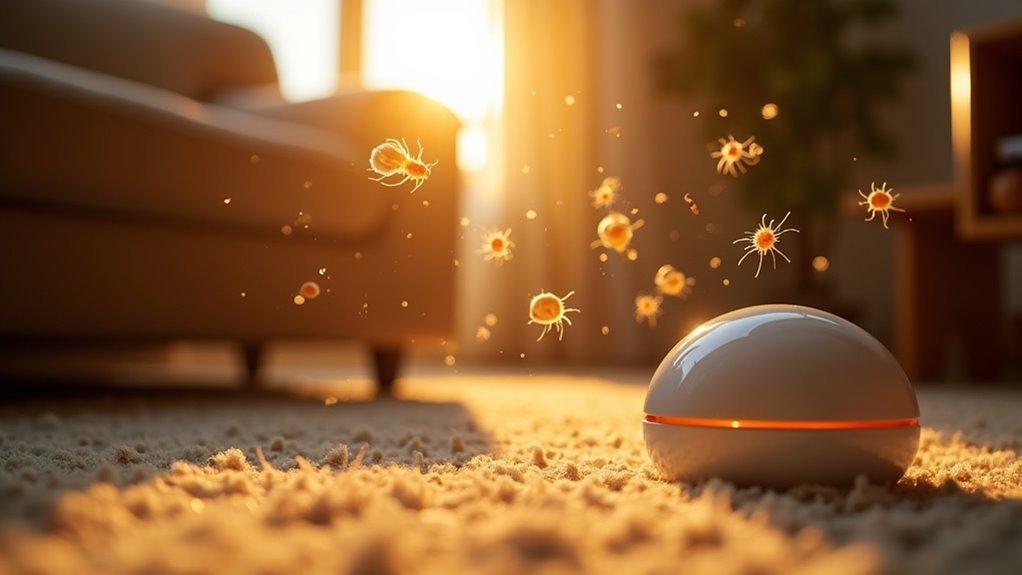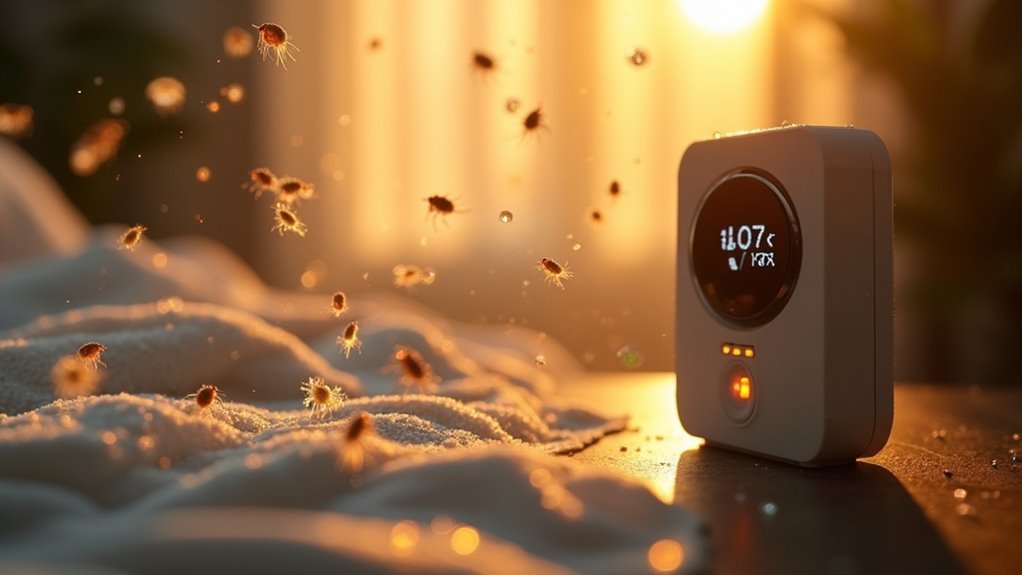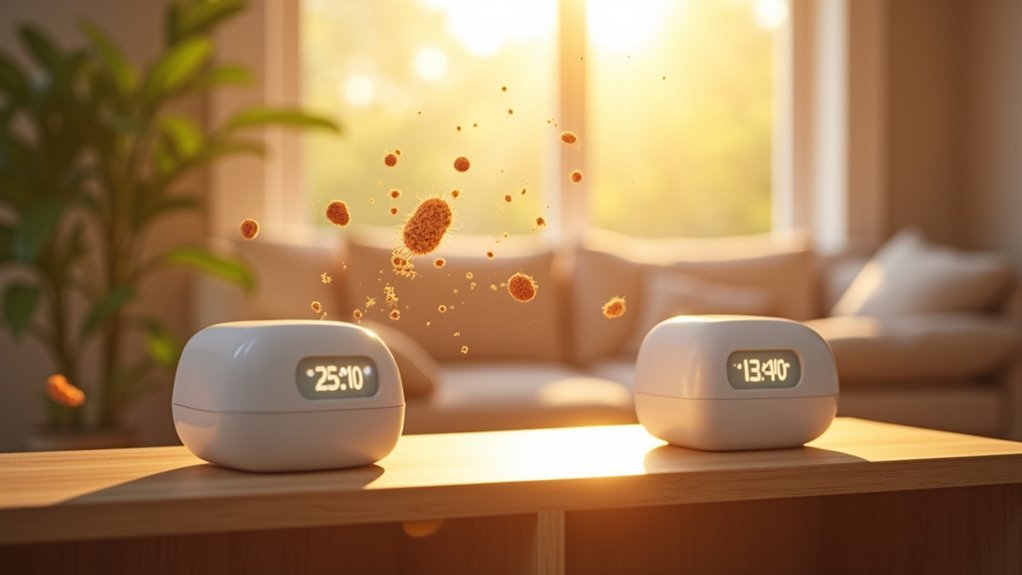You can’t see the microscopic army of allergens floating through your home right now, but they’re there – and they’re affecting your family’s health in ways you probably haven’t considered. Modern air allergen sensors are finally pulling back the curtain on this invisible world, revealing shocking patterns between indoor air quality and everything from your child’s asthma attacks to your own restless nights. What these devices uncover might completely change how you think about your home’s safety.
The Hidden World of Indoor Allergens and Their Health Effects

While you can’t see them floating through your home, countless microscopic allergens are silently wreaking havoc on your health every day. These indoor allergens—including mold spores, pet dander, and dust mites—trigger immune system overreactions that’ll leave you sneezing, experiencing itchy eyes, and struggling with respiratory issues.
You’re facing particles as small as 0.3 microns that remain completely invisible to the naked eye.
Poor air quality in your home intensifies these problems. High humidity and limited ventilation create perfect breeding grounds for allergen buildup, worsening asthma symptoms and causing immediate effects like headaches and dizziness.
High humidity and poor ventilation transform your home into a breeding ground for dangerous allergens that attack your respiratory system.
Long-term exposure puts you at risk for chronic respiratory diseases. Studies show your indoor air can be five times more polluted than outdoor air, making your home environment surprisingly hazardous.
How Air Allergen Sensors Transform Home Health Monitoring
You can now detect invisible allergens in real-time with advanced sensors that monitor pollen, mold spores, and pet dander throughout your home.
These devices don’t just identify current threats—they analyze patterns to predict when you’re likely to experience symptoms and suggest preventive measures before problems arise.
Real-Time Allergen Detection
As homes become increasingly sealed against outdoor elements, indoor air quality has emerged as a critical health concern that traditional monitoring methods simply can’t address effectively.
Air allergen sensors revolutionize this challenge by providing continuous, real-time data about invisible threats in your living space. These advanced devices detect airborne particles like pollen, mold spores, and pet dander the moment they enter your environment.
You’ll receive instant notifications when allergen levels spike, allowing immediate action rather than waiting for symptoms to appear. The sensors track temperature and humidity fluctuations that influence allergen concentration, giving you thorough environmental awareness.
This immediate detection capability transforms how you manage your home’s health, shifting from reactive responses to proactive prevention strategies that protect your family’s wellbeing.
Preventive Health Insights
Beyond detecting immediate threats, air allergen sensors transform your home into a predictive health environment that anticipates problems before they affect your wellbeing.
These devices analyze patterns between environmental conditions like temperature and humidity alongside your personal allergy symptoms, creating a customized health profile that forecasts potential flare-ups.
You’ll receive actionable insights that help you understand when allergens in the air reach dangerous levels, allowing you to make informed decisions about your daily activities.
The sensors’ correlation capabilities reveal hidden connections between your symptoms and specific triggers, empowering you to modify your routine proactively.
This predictive approach to air quality management shifts your health strategy from reactive treatment to preventive care, ultimately reducing asthma episodes and allergic reactions through intelligent environmental awareness.
Smart Environmental Control
Smart air allergen sensors like Sensio AIR don’t just predict health issues—they actively control your home environment to prevent them. These devices integrate seamlessly with your existing smart home systems, automatically triggering air purifiers when allergen levels spike. Through your smartphone app, you’ll receive instant notifications and control recommendations tailored to real-time conditions.
| Environmental Factor | Detection Range | Automated Response | Health Impact | Prevention Action |
|---|---|---|---|---|
| Pollen Levels | 0-1000 grains/m³ | Air purifier activation | Respiratory irritation | Filter air circulation |
| Humidity | 30-70% RH | HVAC adjustment | Mold growth risk | Dehumidifier control |
| Pet Dander | Low-High concentration | Ventilation increase | Allergic reactions | Enhanced filtration |
| Mold Spores | 0-10,000/m³ | Alert system | Asthma triggers | Moisture reduction |
| Temperature | 60-80°F | Climate control | Comfort optimization | Thermostat adjustment |
Real-Time Detection of Dust Mites, Pollen, and Pet Dander
You can’t see dust mites, pollen particles, or pet dander floating through your home, but air allergen sensors detect these microscopic threats in real-time using advanced detection technology.
These invisible invaders trigger your sneezing, congestion, and breathing difficulties, yet traditional methods can’t pinpoint when and where they’re present.
Modern sensors now monitor the health impact of these allergens continuously, giving you immediate alerts when levels spike so you’ll know exactly when your symptoms might worsen.
Invisible Allergen Detection Technology
Millions of allergen particles drift through your home undetected, triggering symptoms without warning.
Invisible allergen detection technology transforms your ability to identify airborne contaminants that cause respiratory distress. These advanced sensors make indoor air pollution visible by detecting microscopic particles you can’t see with the naked eye.
Modern detection systems reveal:
- Dust mite debris floating in seemingly clean rooms
- Pollen concentrations that penetrate closed windows and doors
- Pet dander levels lingering long after animals leave spaces
Your sensor converts invisible threats into actionable data, providing real-time measurements of allergen concentrations.
This technology empowers you to understand when and where exposure occurs, enabling targeted interventions before symptoms escalate.
You’ll finally see what’s been hiding in your air.
Health Impact Monitoring
While conventional air monitoring provides general pollution data, health impact monitoring delivers precise allergen intelligence that directly correlates with your body’s reactions.
These advanced sensors track specific air pollutants like dust mites, pollen, and pet dander in real-time, creating a detailed picture of your indoor environment’s impact on respiratory health.
You’ll receive immediate alerts when particulate matter exceeds safe thresholds, enabling proactive intervention before allergic reactions occur.
The technology monitors humidity and temperature fluctuations that fuel allergen proliferation, particularly dust mites and mold.
Studies confirm that reducing indoor dust mite exposure considerably improves asthma symptoms.
Understanding Humidity’s Role in Allergen Growth and Control

When humidity levels in your home climb above 50%, you’re fundamentally rolling out the welcome mat for two of the most problematic indoor allergens: mold and dust mites.
These microscopic invaders thrive in moisture-rich environments, creating serious respiratory challenges for your family.
Mold begins colonizing surfaces once humidity exceeds 60%, while dust mites reach peak population growth at 70-80% humidity levels.
Here’s what you need to know:
- Maintain indoor humidity between 30-50% to suppress allergen growth
- Use dehumidifiers when moisture levels spike beyond safe thresholds
- Monitor real-time humidity with air allergen sensors for proactive control
Smart Sensor Technology That Makes Invisible Particles Visible
Your best intentions to control humidity mean nothing if you can’t actually see what’s floating in your air.
Smart air allergen sensors like the Sensio AIR transform invisible threats into visible data, detecting pollen, mould spores, and pet dander that trigger your symptoms.
These devices monitor air quality in real-time, tracking allergens alongside temperature, humidity, and light levels that affect irritant presence.
Real-time monitoring reveals the complete picture of your indoor environment, tracking multiple factors that influence allergen activity throughout your day.
You’ll receive instant alerts when allergen levels spike, allowing proactive management before symptoms strike.
The sensors correlate detected particles with your individual reactions, predicting potential flare-ups.
For allergy sufferers, this technology provides tailored recommendations based on specific allergen concentrations in your home.
Instead of guessing what’s causing your discomfort, you’ll have precise data to take targeted action and improve your indoor environment.
Predicting Asthma Attacks Through Environmental Data Analysis

Since asthma attacks often strike without warning, environmental data analysis transforms reactive treatment into proactive prevention. Air quality sensors like the Sensio AIR track real-time allergen levels, correlating this data with your symptoms to identify dangerous patterns. When airborne allergens spike, your risk of experiencing asthma attacks markedly increases.
These smart devices analyze environmental factors to predict potential exacerbations:
- Pattern Recognition – Sensors identify your individual triggers by monitoring pollen, mold spores, and pet dander levels.
- Predictive Alerts – Mobile apps send warnings before allergen concentrations reach your threshold levels.
- Personalized Prevention – Data analysis creates tailored recommendations for avoiding specific environmental triggers.
You’ll receive actionable insights that empower preventive measures, transforming invisible threats into manageable health information for better respiratory outcomes.
Temperature and Light Monitoring for Complete Air Quality Assessment
You’ll find that temperature fluctuations directly affect allergen behavior in your home, with cold air potentially triggering asthma symptoms while warm conditions can increase dust mite activity.
Light exposure plays an essential role in particle management, as natural sunlight helps dry damp areas where mold typically thrives.
Temperature Impact on Allergens
While many homeowners focus solely on humidity levels, temperature serves as an equally critical factor in determining your home’s allergen load. Elevated temperatures create ideal breeding conditions for mold and dust mites, greatly worsening your allergy symptoms.
You’ll want to keep indoor temperatures below 70°F to minimize mold growth, which thrives in warmer environments.
Your air allergen sensors that monitor both temperature and humidity provide thorough insights into conditions that favor allergen development.
Consider these temperature-related impacts:
- High temperatures increase airborne mold spores and dust mite populations
- Temperature fluctuations trigger VOC release from household products
- Warmer conditions amplify humidity effects on allergen proliferation
Understanding how temperature influences allergens helps you make informed decisions about your home’s climate control and overall air quality management.
Light Effects on Particles
Beyond temperature control, light exposure dramatically influences how allergens behave and multiply throughout your home.
You’ll find that mold and dust mites thrive in specific lighting conditions, making light monitoring essential for controlling these problematic particles. When you track light levels alongside particle counts, you’re getting a thorough picture of your indoor environment’s health impact.
Your air quality sensors reveal how natural sunlight exposure affects allergen proliferation patterns. Certain particles flourish in darker spaces, while others respond differently to varying light intensities.
Connecting Air Quality Data to Daily Symptom Patterns
When you start tracking allergen levels alongside your daily symptoms, meaningful patterns emerge that reveal your personal health triggers.
Air quality sensors provide real-time data about pollen, mold spores, and pet dander in your environment, creating a thorough picture when correlated with your symptom reports.
This data integration helps you understand how environmental factors affect your health:
- Predictive alerts warn you about rising allergen levels before symptoms worsen
- Environmental correlations reveal how temperature and humidity influence your reactions
- Personalized insights identify specific triggers unique to your living space
Mobile App Integration for Personalized Health Insights
The mobile app becomes your command center for transforming raw allergen data into actionable health insights.
You’ll receive real-time updates on airborne allergens like pollen and pet dander in your environment, helping you understand what’s triggering your symptoms.
The app analyzes correlations between indoor air quality and your reported health patterns, delivering personalized insights that pinpoint specific allergens affecting you most.
You’ll get tailored recommendations based on detected allergen levels, enabling you to proactively adjust your environment.
Smart alerts notify you when allergen concentrations spike, so you can take immediate action to reduce exposure.
This integration makes monitoring effortless, allowing you to adapt your daily routine for ideal indoor air quality management.
Creating Allergen-Free Zones Using Sensor Feedback
You can transform sensor data into actionable insights by analyzing allergen patterns throughout your home to identify the cleanest areas for establishing safe zones.
Strategic placement of these zones in rooms with consistently low allergen readings creates retreats where you’ll experience minimal exposure to triggers like pollen and pet dander.
Real-time adjustments based on current sensor feedback let you maintain these spaces by immediately addressing any detected allergen spikes through targeted cleaning or air purification.
Sensor Data Analysis
As allergen sensors continuously monitor your indoor air quality, they’re generating valuable data streams that reveal hidden patterns about pollutant distribution throughout your home.
This information becomes powerful when you analyze trends over time, identifying peak allergen periods and their triggers.
Your allergen sensors collect extensive datasets that enable predictive health management:
- Symptom forecasting – Historical data patterns help predict when allergy or asthma symptoms might worsen based on environmental conditions
- Seasonal trend mapping – Track how different allergens fluctuate throughout the year to prepare proactive countermeasures
- Correlation analysis – Understand relationships between temperature, humidity, and specific allergen concentrations in your living spaces
Strategic Zone Placement
Use the data to prioritize cleaning efforts and maintenance schedules.
Focus intensive allergen reduction strategies in rooms showing consistently high readings while maintaining protective zones in bedrooms and living areas for ideal health outcomes.
Real-Time Air Adjustments
Building on your strategic sensor placement, real-time air adjustments transform your home into an adaptive allergen defense system. Your sensors continuously monitor air quality, detecting pollen, mold spores, and pet dander to trigger immediate responses.
When allergen levels spike, integrated smart purifiers automatically increase filtration intensity, maintaining ideal conditions without your intervention.
Your system creates dynamic allergen-free zones by:
- Automatically adjusting purifier settings when sensors detect elevated particle concentrations
- Monitoring temperature and humidity levels to prevent mold-promoting conditions
- Sending instant alerts during high pollen counts or when pet dander accumulates
This real-time feedback empowers you to take proactive measures like closing windows or relocating to cleaner zones.
You’ll receive recommendations that help maintain consistently healthy air quality throughout your living spaces.
The Science Behind HEPA Filtration and Smart Purifier Integration
When you’re dealing with airborne allergens in your home, HEPA filtration technology works as your first line of defense by capturing 99.97% of particles as small as 0.3 microns—including dust, pollen, and pet dander that trigger allergic reactions.
Smart air purifiers take this protection further by integrating advanced sensors that monitor your indoor air quality continuously. These devices automatically adjust their filtration settings when they detect rising pollutant levels, ensuring peak performance without manual intervention.
Smart sensors continuously monitor air quality and automatically optimize filtration settings, delivering protection without any manual adjustments needed.
This dynamic response system means you’ll receive immediate protection during allergen spikes, while mobile app integration provides real-time notifications about your air quality.
Studies demonstrate that this technology combination considerably reduces asthma and allergy symptoms by maintaining consistently lower indoor allergen concentrations throughout your living space.
Building a Comprehensive DIY Home Air Monitoring Network
While individual air purifiers provide targeted filtration, you’ll gain deeper insights into your home’s air quality patterns by establishing a network of strategically placed sensors throughout different rooms and zones.
These extensive systems detect allergens like pollen, pet dander, and mold spores while monitoring temperature, humidity, and airborne particles. You’ll create a holistic view of your indoor environment and identify specific health triggers.
Modern monitoring systems offer several key advantages:
- Real-time alerts through mobile apps with tailored recommendations based on detected allergen levels
- Automatic integration with air purifiers for immediate adjustments when air quality deteriorates
- Long-term data tracking to identify patterns and optimize your home’s air management strategy
This approach helps manage asthma and allergies effectively, since poor indoor air quality can exacerbate symptoms and create lasting health complications.
Long-Term Health Benefits of Continuous Allergen Tracking
As you maintain continuous allergen tracking over months and years, you’ll discover profound improvements in your respiratory health that extend far beyond immediate symptom relief.
Your consistent monitoring creates a personalized health profile that reveals specific triggers affecting your well-being. You’ll notice fewer emergency hospital visits and reduced healthcare expenses as you proactively manage your indoor air quality rather than reactively treating symptoms.
Proactive air quality management reduces emergency visits and healthcare costs while creating a personalized health profile of your specific triggers.
The data you collect enables precise environmental adjustments—optimizing air purifier usage, controlling humidity levels, and timing cleaning activities.
You’ll develop deeper insights into seasonal patterns and daily fluctuations that impact your health. This long-term approach transforms your living space into a therapeutic environment, where informed decisions about air quality management lead to sustained respiratory improvements and enhanced quality of life.
Choosing the Right Air Allergen Sensor for Your Home’s Needs
How should you navigate the overwhelming array of air allergen sensors flooding today’s market? Start by prioritizing devices that detect thorough airborne particles like pollen, mold spores, and pet dander.
You’ll want real-time monitoring of temperature and humidity since these factors directly influence allergen levels and growth patterns.
Consider these essential features:
- Smartphone app connectivity for personalized notifications and recommendations
- Historical data tracking to identify correlations between air quality and symptoms
- User-friendly interface with clear displays for easy interpretation
Choose a sensor that monitors allergen levels continuously while providing actionable insights.
The right device transforms raw data into meaningful patterns, helping you understand how your home’s air quality impacts your health and enabling proactive allergen management decisions.
Frequently Asked Questions
Am I Allergic to the Air in My House?
You can’t be allergic to air itself, but you’re likely reacting to allergens floating in your home’s air like dust mites, mold spores, pet dander, or pollen particles.
Do Air Quality Monitors Detect Allergens?
Yes, air quality monitors can detect allergens like pollen, mold spores, and pet dander in your home. They’ll track these particles in real-time and send alerts to your smartphone when allergen levels rise.
Why Are My Allergies so Bad Inside My House?
Your indoor allergies worsen because your house traps pet dander, dust mites, and mold spores. Poor ventilation and high humidity create perfect breeding conditions for allergens that you’re constantly breathing.
How Do They Measure Indoor Dust and Dander Levels?
Air allergen sensors use laser technology to detect particles as small as 0.3 microns in your air. They’ll count and categorize dust, dander, and other allergens, then send real-time measurements to your smartphone app.





Leave a Reply